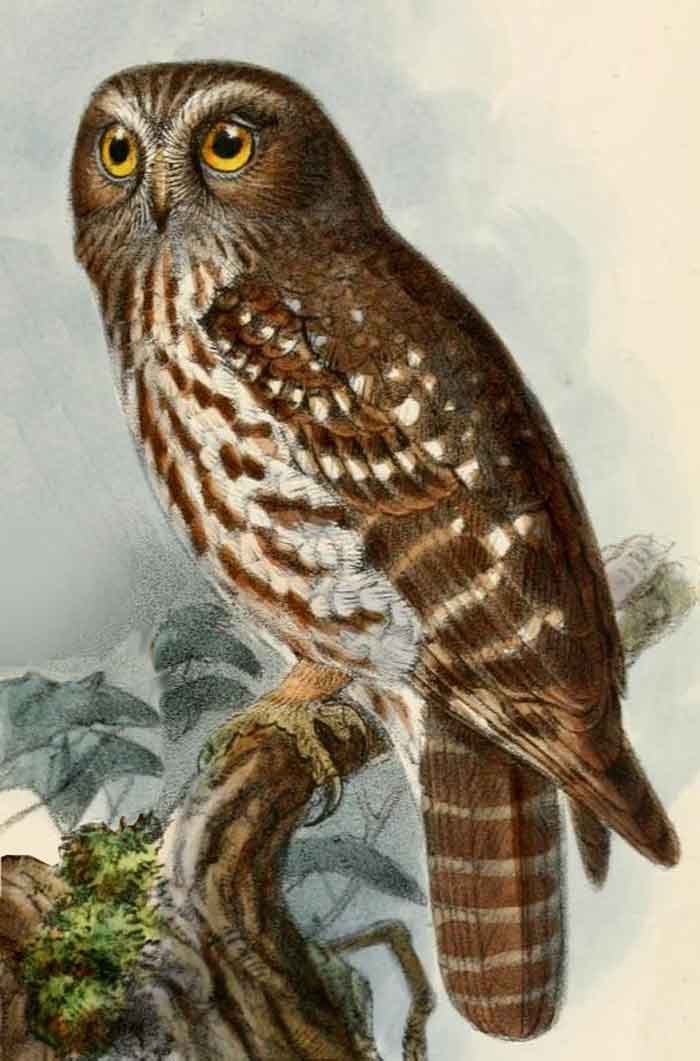Superregnum: Eukaryota
Regnum: Animalia
Subregnum: Eumetazoa
Cladus: Bilateria
Cladus: Nephrozoa
Superphylum: Deuterostomia
Phylum: Chordata
Cladus: Craniata
Subphylum: Vertebrata
Infraphylum: Gnathostomata
Superclassis: Tetrapoda
Cladus: Reptiliomorpha
Cladus: Amniota
Classis: Reptilia
Cladus: Eureptilia
Cladus: Romeriida
Subclassis: Diapsida
Cladus: Sauria
Infraclassis: Archosauromorpha
Cladus: Crurotarsi
Divisio: Archosauria
Subsectio: Ornithodira
Subtaxon: Dinosauromorpha
Cladus: Dinosauria
Ordo: Saurischia
Cladus: Theropoda
Cladus: Neotheropoda
Infraclassis: Aves
Cladus: Euavialae
Cladus: Avebrevicauda
Cladus: Pygostylia
Cladus: Ornithothoraces
Cladus: Euornithes
Cladus: Ornithuromorpha
Cladus: Ornithurae
Cladus: Carinatae
Parvclassis: Neornithes
Cohors: Neognathae
Ordo: Strigiformes
Familia: Strigidae
Subfamilia: Surniinae
Genus: Ninox
Species: N. affinis - N. boobook - N. burhani - N. connivens – N. forbesi – N. hypogramma – N. ios – N. jacquinoti – N. japonica – N. leventisi – N. meeki – N. mindorensis – N. natalis – N. novaeseelandiae – N. obscura – N. ochracea – N. odiosa – N. philippensis – N. punctulata – N. randi – N. reyi – N. rudolfi – N. rufa – N. rumseyi – N. scutulata – N. spilocephala – N. spilonotus – N. squamipila – N. strenua – N. sumbaensis – N. theomacha – N. variegata
Species: N. affinis - N. boobook - N. burhani - N. connivens - N. ios - N. jacquinoti - N. japonica - N. meeki - N. natalis - N. novaeseelandiae - N. ochracea - N. odiosa - N. philippensis - N. punctulata - N. rudolfi - N. rufa - N. scutulata - N. squamipila - N. strenua - N. sumbaensis - N. superciliaris - N. theomacha -
Name
Ninox Hodgson, 1837
Typus
Ninox nipalensis Hodgson, 1837, = Strix lugubris Tickell, 1833, = Ninox scutulata lugubris
References
Madras Journal of Literature and Science 5: 23.
Rasmussen, P.C., Allen, D.N.S., Collar, N.J., DeMeulemeester, B., Hutchinson, R.O., Jakosalem, P.G.C., Kennedy, R.S., Lambert, F.R. & Paguntalan, L.M. 2012. Vocal divergence and new species in the Philippine Hawk Owl Ninox philippensis complex. Forktail 28: 1–20. Full article (PDF).Reference page.
Vernacular names
English: Hawk-owls
日本語: アオバズク属

Ninox fusca

Ninox squamipila
Ninox is a genus of true owls comprising 36 species found in Asia and Australasia. Many species are known as hawk-owls or boobooks, but the northern hawk-owl (Surnia ulula) is not a member of this genus.
Taxonomy
The genus was introduced by English naturalist Brian Houghton Hodgson in 1837 with the type species as Ninox nipalensis, a junior synonym of Strix lugubris Tickell 1833. Strix lugubris is now considered a subspecies of the brown boobook (Ninox scutula lugubris).[2][3]
Seram boobook (N. squamipila) (left); Timor boobook (N. fusca) (right)
Species
The genus contains the species:[4]
† Laughing owl, Ninox albifacies (extinct)
Rufous owl, Ninox rufa
Powerful owl, Ninox strenua
Barking owl, Ninox connivens
Sumba boobook, Ninox rudolfi
Australian boobook, Ninox boobook
Rote boobook Ninox rotiensis
Timor boobook Ninox fusca
Alor boobook, Ninox plesseni
Tasmanian boobook, Ninox leucopsis
Morepork, Ninox novaeseelandiae
Northern boobook, Ninox japonica
Brown boobook, Ninox scutulata
Hume's boobook, Ninox obscura
Chocolate boobook, Ninox randi
Andaman boobook, Ninox affinis
Philippine hawk-owl group
Luzon boobook, Ninox philippensis
Mindanao boobook, Ninox spilocephala
Camiguin boobook, Ninox leventisi
Sulu boobook, Ninox reyi
Cebu boobook, Ninox rumseyi
Romblon boobook, Ninox spilonotus
Mindoro boobook, Ninox mindorensis
Least boobook, Ninox sumbaensis
Togian boobook, Ninox burhani
Ochre-bellied boobook, Ninox ochracea
Cinnabar boobook, Ninox ios
Moluccan boobook group
Halmahera boobook, Ninox hypogramma
Buru boobook, Ninox hantu
Seram boobook, Ninox squamipila
Tanimbar boobook, Ninox forbesi
Christmas boobook, Ninox natalis
Manus boobook, Ninox meeki
Papuan boobook, Ninox theomacha
Speckled boobook, Ninox punctulata
New Britain boobook, Ninox odiosa
New Ireland boobook, Ninox variegata
Genomic studies of the extinct laughing owl of New Zealand indicate that it actually belongs in Ninox rather than the monotypic genus Sceloglaux.[5] The fossil owls "Otus" wintershofensis and "Strix" brevis, both from the Early or Middle Miocene of Wintershof, Germany, are close to this genus; the latter was sometimes explicitly placed in Ninox (Olson 1985), but is now in Intutula. "Strix" edwardsi from the Late Miocene of La Grive St. Alban, France,might also belong into this group.[citation needed]
In human culture
"NINOX" is an Australian Army project to develop night-vision goggles; it is named after Ninox strenua.
References
"Strigidae". aviansystematics.org. The Trust for Avian Systematics. Retrieved 2023-07-26.
Hodgson, Brian Houghton (1837). "Indication of a new genus belonging to the Strigine family, with description of the new species and type". Madras Journal of Literature and Science. 5: 23–25.
Dickinson, E.C.; Remsen, J.V. Jr., eds. (2013). The Howard & Moore Complete Checklist of the Birds of the World. Vol. 1: Non-passerines (4th ed.). Eastbourne, UK: Aves Press. p. 258. ISBN 978-0-9568611-0-8.
Gill, Frank; Donsker, David; Rasmussen, Pamela, eds. (January 2021). "Owls". IOC World Bird List Version 11.1. International Ornithologists' Union. Retrieved 20 May 2021.
Wood, Jamie R.; Mitchell, Kieren J.; Scofield, R. Paul; Pietri, Vanesa L. De; Rawlence, Nicolas J.; Cooper, Alan (2016). "Phylogenetic relationships and terrestrial adaptations of the extinct laughing owl, Sceloglaux albifacies (Aves: Strigidae)". Zoological Journal of the Linnean Society. doi:10.1111/zoj.12483. ISSN 1096-3642.
Olson, Storrs L. (1985): IX.C. Strigiformes. In: Farner, D.S.; King, J.R. & Parkes, Kenneth C. (eds.): Avian Biology 8: 129–132. Academic Press, New York.
Further reading
Gwee, CC.Y.; Christidis, L.; Eaton, J.A.; Norman, J.A.; Trainor, C.R.; Verbelen, P.; Rheindt, F.E. (2017). "Bioacoustic and multi-locus DNA data of Ninox owls support high incidence of extinction and recolonisation on small, low-lying islands across Wallacea". Molecular Phylogenetics and Evolution. 109: 246–58. Bibcode:2017MolPE.109..246G. doi:10.1016/j.ympev.2016.12.024. PMID 28017857.
Retrieved from "http://en.wikipedia.org/"
All text is available under the terms of the GNU Free Documentation License

